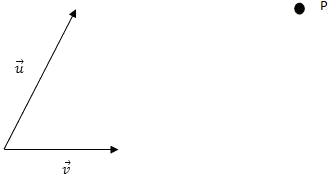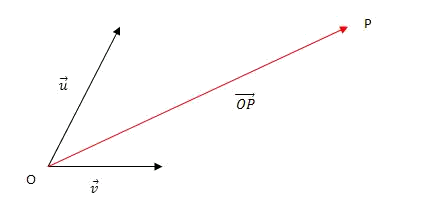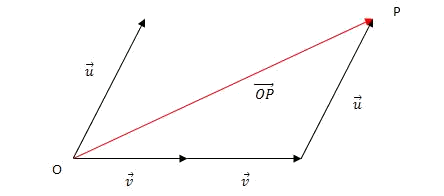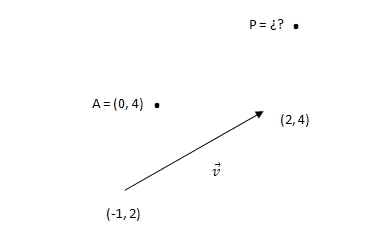Coordinates of a point on the plane
Let's see how vectors are used to assign coordinates to the points in the plane.
We consider a fixed point in the plane $$O$$ (known as origin), and a basis $$B=\{\overrightarrow{u}, \overrightarrow{v}\}$$ of $$V_2$$ (Space vector of dimension $$2$$).
Let's remember that a basis of $$V_2$$ are two linearly independent vectors. The set formed by $$O$$ and $$B=\{\overrightarrow{u}, \overrightarrow{v}\}$$ constitutes a reference system in the plane, since it allows us to determine the position of any other points on the plane.
This is because any other points $$P$$ on the plane determines along with point $$O$$ a vector $$\overrightarrow{OP}$$. Let $$(p_1,p_2)$$ be the components of the vector in basis $$B$$. Then $$(p_1,p_2)$$ are the coordinates of point $$P$$ in the reference system $$R=\{O;\overrightarrow{u}, \overrightarrow{v}\}$$ and we write $$P =(p_1,p_2)$$.
The procedure to find the coordinates of point $$P$$ in a given reference system is the following :
-
From the points $$O$$ and $$P$$ we determine the vector $$\overrightarrow{OP}$$
-
We express the vector $$\overrightarrow{OP}$$ as a linear combination of the vectors of the basis$$B=\{\overrightarrow{u}, \overrightarrow{v}\}$$, that is to say, $$\overrightarrow{OP}=p_1 \cdot \overrightarrow{u}+p_2 \cdot \overrightarrow{v}$$
- $$P=(p_1,p_2)$$
Express point $$P$$ of the drawing in the reference system $$R =\{O;\overrightarrow {u}, \overrightarrow{v}\}$$.

- We draw the vector $$\overrightarrow{OP}$$:

- We express the vector $$\overrightarrow{OP}$$ as a linear combination of the vectors of the basis $$B=\{\overrightarrow{u}, \overrightarrow{v}\}$$:

- We obtain $$\overrightarrow{OP}=\overrightarrow{u}+2\overrightarrow{v}$$ and therefore the coordinates of the point $$P$$ are $$P = (1 , 2)$$
From now on we will consider, as reference system $$R$$, the one formed by the origin of coordinates $$O = (0, 0)$$ and the canonical basis of $$V_2$$ $$B =\{\overrightarrow{i},\overrightarrow{j}\}$$.
Components of a vector determined by two points
Let's see now the way to determine the components of a vector if we know the coordinates of its endpoints:
Let $$P =(p_1,p_2)$$ and $$Q = (q_1,q_2)$$ be two points of the plane, and $$\overrightarrow{PQ}$$ the vector that goes from $$P$$ to $$Q$$. Then the components of the vector $$\overrightarrow{PQ}$$ are $$\overrightarrow{PQ}=(q_1-p_1,q_2-p_2)$$.
Given $$P = (2, 6)$$ and $$Q = (-3, 9)$$. The components of the vector $$\overrightarrow{PQ}$$ are:$$\overrightarrow{PQ}= (-3 - 2, 9 - 6) = (-5, 3)$$
Applying a vector to a point
Given a point $$P$$ and a vector $$\overrightarrow{v}$$, the result of applying the vector to the point is a new point $$Q$$ placed in the direction of $$\overrightarrow{v}$$ and at a distance $$|\overrightarrow{v}|$$. (module of the vector $$\overrightarrow{v}$$)
The coordinates of this new point $$Q$$ are calculated from those of $$P =(p_1,p_2)$$ and $$\overrightarrow{v}=(v_1,v_2)$$ thus $$$Q = P +\overrightarrow{v}=(p_1+v_1,p_2+v_2)$$$
NOTE: It is very important to bear in mind that this addition operation only makes sense between a point and a vector. We must never add two points, and the result of adding two vectors is another vector and not a point!
Considering the following figure, determine the coordinates of point $$P$$ of the figure, the result of applying the vector $$\overrightarrow{v}$$ to the point $$A$$.

We begin by calculating the components of the vector $$\overrightarrow{v}$$:$$$\overrightarrow{v} = (2 - (-1), 4-2) = (3, 2)$$$ Since $$P$$ is the result of applying the vector $$\overrightarrow{v}$$ to the point $$A$$ we have,$$$P=A+\overrightarrow{v}=(0,4)+(3,2)=(3,6)$$$
Midpoint of a segment
Let's consider now a segment with endpoints $$A = (a_1,a_2)$$ and $$B = (b_1,b_2)$$. Let $$M =(m_1,m_2)$$ be the midpoint of the above mentioned segment. Obviously the above mentioned point satisfies that $$\overrightarrow{AB}=2\cdot \overrightarrow{AM}$$, or that $$(b_1-a_1,b_2-a_2)=2\cdot (m_1-a_1,m_2-a_2)$$
Separating component by component we obtain: $$$\begin{array}{rcl} b_1-a_1 & = & 2 \cdot (m_1-a_1) \\ b_2-a_2 &=& 2\cdot (m_2-a_2) \end{array}$$$ and isolating we have: $$$\begin{array}{rcl} m_1 & = & \displaystyle \frac{a_1+b_1}{2}\\ m_2 &=& \displaystyle \frac{a_2+b_2}{2} \end{array}$$$ So that we can calculate the coordinates of the midpoint of a segment from the coordinates of its endpoints.
Considering the points $$A = (-3, 7)$$ and $$B = (1, 2)$$ find the midpoint of the segment that they determine.
Applying the previous formulas we have: $$$\begin{array}{rcl} m_1 & = & \displaystyle \frac{a_1+b_1}{2}= \frac{-3+2}{2}=-1\\ m_2 &=& \displaystyle \frac{a_2+b_2}{2}=\frac{7+2}{2}=\frac{9}{2} \end{array}$$$ Therefore the midpoint of the segment $$AB$$ is $$M = (-1, \displaystyle \frac{9}{2})$$
